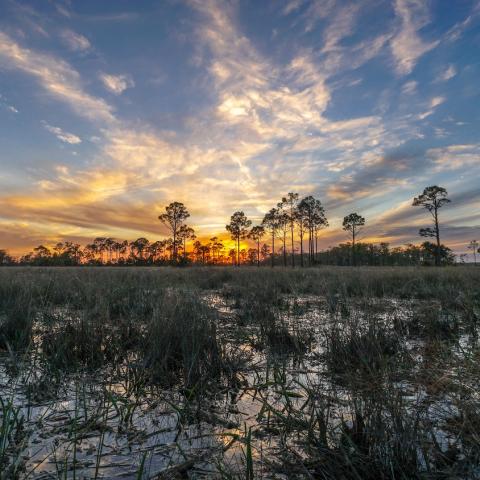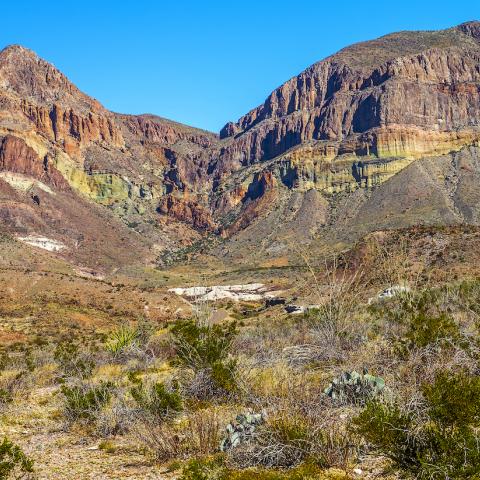
Big Bend National Park officials need to replace the main water line that brings water from Oak Spring up into the Chisos Basin, where the Chisos Mountains Lodge stands/Rebecca Latson file
Climatology is factoring into the future of visitation at Big Bend National Park, at least when it comes to landing a room inside the rugged and sprawling swath of Chihuahuan ecosystem protected by the park in West Texas.
Of course, decision-making by park managers is more complicated than that opening sentence might imply, but when it comes to filling a glass of water at the Chisos Mountains Lodge, rain- and snowfall play a key role, and climate change is expected to infuse more unpredictability in annual precipitation for the West Texas region than for just about anywhere else in North America.
Driving the issue is the pipeline that draws water from Oak Spring and pumps it uphill roughly 2.5 miles to the Chisos Basin and the lodge. It is near the end of its life, and park officials need to consider the best approach to replacing it; do they simply install a new pipeline, or search for a new water source and pipe it in from there?
Climate change is bringing many impacts to the National Park System and forcing park managers to come up with a range of approaches to dealing with those impacts. At Big Bend, how to ensure water will flow when a faucet is turned is key for visitation and human safety. So along with designing a new pipeline, Big Bend's management team needs to factor in how climate change will affect Oak Spring, as its flow largely is dictated by that water which falls from the sky.
"We’ve not had the kinds of leaks and bursts that the Grand Canyon (pipeline) has had, but it’s old and much of the pipe is exposed," Big Bend Superintendent Bob Krumenaker said of his pipeline dilemma. "It was buried, but erosion has exposed much of the pipe. We’re trying to be proactive. We know that we’ll have major problems if we don’t do something.”
Big Bend officials for some time have been aware of their impending need to replace the Oak Spring pipeline that carries water uphill about 2,000 feet to reach the Chisos Basin, where it serves visitor needs as well as those of park employees and concession workers, and is available for firefighting.
The basin attracts most of the park's visitors. Roughly three-quarters of the national park's roughly 460,000 visitors a year heads to the Chisos Basin for day or overnight visits. There they find the Chisos Mountains Lodge, which offers 80 rooms; a 60-site campground; convenience store; visitor center, and; a dozen employee residences.
At one point several years ago park officials sought some guidance from the Park Service's Climate Change Response Program in Fort Collins, Colorado, regarding continued use of Oak Spring into the future. That team late last year produced a report that analyzed water flows from the spring. The findings were not overwhelmingly encouraging, though considering the exisiting situation, not overly depressing, either.

Failure of the outdated water delivery system would be disastrous for the park/Rebecca Latson file
The report made clear that precipitation is a key driver of Oak Spring, pointing out that the spring's "flows correlate with monthly precipitation falling in the local area, with a two-month lag time, where precipitation explained 58% of the variation in spring flow."
It's been calculated that a spring flow of 20 gallons per minute is sufficient to meet the needs in the Chisos Basin. Using that number as a threshhold, the Fort Collins team predicted that, under the "best case scenario" of a warming world and precipitation models, Oak Spring in the 2060s will continue to produce water at the same rate as it did during the 1950-2000 historical period.
However, under a "hot dry scenario" -- reduced precipitation, increased temperatures -- the spring's production will fall significantly, failing to reach 20 gpm in the 2060s twice as often as it did during the 1950-2000 period.
"By evaluating different scenarios of change, managers can stress-test the decision about whether to re-develop Oak Spring or seek an alternative water source, considering how different climatic changes may influence the long-term reliability of this water source," the Climate Change Response Program report said.
It will be a costly decision. Currently projections say replacing the Oak Spring pipeline from source to Chisos Basin will cost in the range of $8 million-$10 million, an estimate Krumenaker says is probably on the low side. But the alternative, to pipe in water from a larger and possibly more reliable aquifer at Lone Mountain, a distance of about eight miles, would probably cost the Park Service even more, both in dollars and resource damage as a path for a pipeline is dug, he said.
A team contracted with the Intermountain Region office is expected to visit Big Bend this year and develop detailed cost estimates for the Oak Spring project, though the superintendent is confident the park can continue to rely on Oak Spring for years to come once the new pipeline is in place and leaks in the system are sealed.
Plus, "I’m committed to not increasing the overnight capacity in the basin," said Krumenaker. "The biggest need for water is people who spend the night, whether they live there or whether they stay in hotels. So, with all the other conversations we’ve had about possible redevelopment, my bottom line is no more motel units. That’s based primarily on water, but also on fire safety. We need to have enough water up there to put out a fire, or at least protect the people in structures that are there."
The current pipeline was installed in 1955. While the national park claims more than 300 springs, Oak Spring was chosen to serve Chisos Basin because its location at the western foot of the Chisos range "benefits from the higher precipiptation rates common in that area," according to park records.
Since monitoring of the spring's output began in 1985, the outflow has ranged widely; two years ago that rangee went from 19 gpm to 191 gpm, the records note. Usually, however, the flow ebbs and spews between 17 gpm and 83 gpm. That said, the pipeline is beyond its estimated life. Failure would be disastrous for the park.
"This water system is a single point of failure, and if the line has a major break, no water will reach the visitors at the campgrounds, visitor center or lodge. With no water, park and concessions operations will need to shut down," according to park officials. "An estimated 500 people per day would be affected, and $12-15,000 worth of revenue would be lost."
How much water for the Chisos Basin is enough is a good question? From 2015 to 2018, visitation to the park grew by 15 percent, and water use in the Chisos Basin rose 136 percent, with consumption approaching nearly 7 million gallons in 2018. At the same time, how much of the Oak Spring's water actually makes it to a faucet or hose tap is up in the air. According to park staff, "in 2017, 3,763,080 gallons were pumped and distributed into the basin and lost to record" due to faulty water meters and leaks."
Put another way, roughly half of the water pumped to the basin can't be accounted for.
Krumenaker is approaching the issue pragmatically.
"I’m confident that for the same capacity, we can use a lot less water, with a lot more efficient infrastructure," he said.
The existing lodge needs, at a minimum, to be rehabilitated, the superintendent said, and he hopes such a project would enlarge the dining room and bring 21st century efficiencies to the water system.
"I’m confident that if we had a really efficient kitchen system and dishwashing system and all the rest of it, we wouldn’t use any more water than we’re using right now," he said. "So it’s not simply a case of how many people can it support, it’s a case of does the infrastructure waste water, or is it very, very efficient? Right now, we’re not the least bit efficient up there.”
Along with addressing water line leakage and improving efficiencies in water delivery, Krumenaker wants to increase the water storage capacity for the Chisos Basin. Currently, there's storage for about 1 million gallons of Oak Spring water, and he would like to double that.
“I do believe that, except under the most extraordinary drought conditions, and those certainly could happen, we will probably be able to support the number of people we have in the basin because the physical capacity of the basin is not going to go up,” the superintendent said.
How quickly the problem can be addressed is another question. Not only is a new pipeline expected to cost in the range of $8 million to $10 million, if not more, fixing leaks in distribution lines and installing modern water meters in the Chisos Basin and down at park headquarters at Panther Junction currently is expected to run $21 million.
Meanwhile, the National Park System's maintenance backlog is roughly $12 billion. At Big Bend, the number was listed in 2018 as roughly $90 million.




 Support Essential Coverage of Essential Places
Support Essential Coverage of Essential Places







Comments
There are a couple of thousand gallons per day being released from the waste water treatment plant that perhaps could be added to the system.
I am a camper who visits the Chihuauan Desert frequently. My suspicion is a lodge with 80 rooms uses a lot of water doing laundry. I would suggest visitors be required to use sleeping bags, to reduce water requirements.